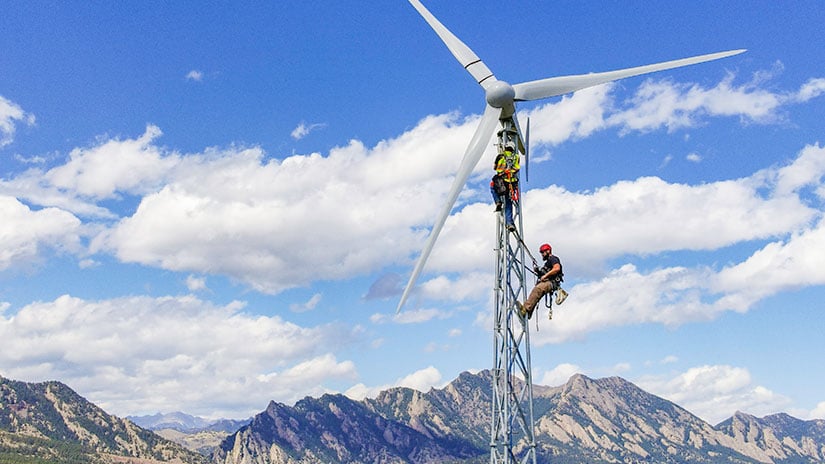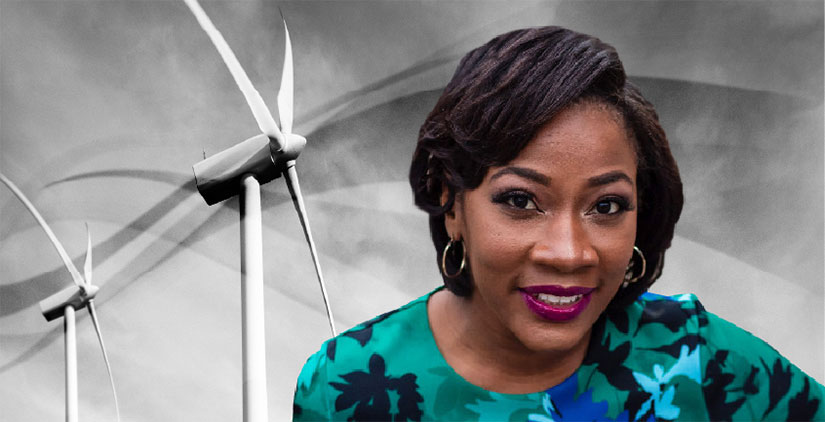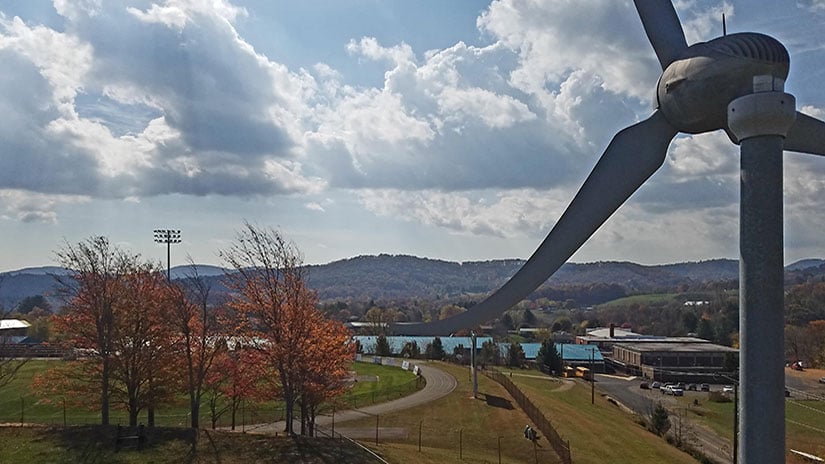The Leading Edge: February 2024 Wind Energy Newsletter
In this issue, NREL opens a distributed wind improvement project opportunity, celebrates an inspirational researcher, and shares the latest wind energy news, opportunities, and publications.
Upwind: Featured News
NREL Requests Proposals From U.S. Distributed Wind Energy Manufacturers

The National Renewable Energy Laboratory has issued a request for proposals under the Competitiveness Improvement Project, which awards cost-shared subcontracts and national laboratory technical support to U.S. component suppliers and manufacturers of small- and medium-sized wind turbines. The 2024 Competitiveness Improvement Project will prioritize projects that provide certified wind technology options, support commercialization, address the need for distributed-wind-turbine-specific inverters, and enhance manufacturing processes. In addition, in response to changing U.S. requirements, a new topic area focuses on inverter listing. Since its inception in 2012, the Competitiveness Improvement Project has awarded $15.4 million in U.S. Department of Energy (DOE) funding, leveraging an additional $7.9 million in private-sector investment across 26 companies. Proposals are due by 2 p.m. MT on March 27, 2024.
Behind the Blades
How Angel McCoy’s Background in Meteorology Propels Offshore Wind Forward

When Angel McCoy was in third grade, she fell in love with the sky.
“I became obsessed with weather, space, and earth science,” recalled the NREL senior offshore wind regulatory specialist. “I knew I was either going to be a meteorologist or an astronaut when I grew up.”
McCoy chose meteorology and started her career as a meteorologist at the National Weather Service’s Climate Prediction Center, where she worked for 4 years before taking a job at the U.S. Department of the Interior’s Bureau of Ocean Energy Management (BOEM). That role wasn’t what she expected, but it put her on the path that led to her current role at NREL.
“When I worked at the National Weather Service, I wrote code for things like rainfall modeling. So when I took the job at BOEM, I thought I’d be writing code for wind and solar models,” said McCoy. “It turned out my new job was a regulatory position, which meant I needed to know environmental law. That was a shocking realization. But I saw the need for sound science to inform regulations, so I made a commitment to stick it out for 5 years. I fell in love with the work and stayed for 12 years.”
Today, McCoy works in NREL’s offshore wind energy program, where she leads engagement with the Bureau of Ocean Energy Management and the Bureau of Safety and Environmental Enforcement to support the regulatory process for offshore wind energy in the United States.
We caught up with McCoy to learn how she made her way to her current role and how she invests in the next generation of scientists and clean energy leaders. Read the full Q&A to learn what she shared.
On the Radar: Project Updates
National Offshore Wind Workforce Network Expands To Include Land-Based Wind Energy
NREL is working to expand the National Offshore Wind Workforce Network into the Wind Energy Workforce Network Initiative, which will provide a forum for stakeholders across wind energy technologies and regions to collaborate, learn from each other, prioritize challenges and opportunities, and develop targeted solutions. If you are interested in wind energy workforce development and would like to join the network, reach out to Chloe Constant.
Distributed Wind Energy Resource Hub Launches

The new Distributed Wind Energy Resource Hub is designed for anyone interested in harnessing the power of distributed wind energy. This curated directory of resources, published on the Wind Energy Technology Office’s WINDExchange website, will help you find information on everything from the basics of wind power to installing wind turbines on your land or in your community. Authored by Ruth Baranowski and Suzanne MacDonald at NREL, along with Danielle Preziuso at Pacific Northwest National Laboratory, on behalf of DOE’s Wind Energy Technologies Office, the hub also offers researchers and developers information on project funding and tools to evaluate the economics of a distributed wind energy project.
Downwind: In Case You Missed It
NREL-Led Workshop Explored Future of Renewable Energy, Including Wind Power
Large portions of the U.S. energy infrastructure are served by technologies that have historically been minor providers. As the country transitions to renewable energy technologies, it is important to mitigate the risks of large-scale maintenance issues by better understanding the degradation mechanisms of those new technologies. This was the focus of a recent cross-disciplinary, 2-day workshop organized by NREL, which followed a year of meetings between NREL researchers in wind energy, solar power, batteries, and electrolyzers and the publishing of a paper in the journal Joule, titled Nanoscale Science for Terawatt/Gigaton Scale Performance of Clean Energy Technologies, coauthored by Paul Veers. Researchers identified and discussed several challenges, such as access to reliable and publicly available data, identification of how microscopic weaknesses progress to the macroscopic level in each technology, and standards that focus on durability. Most of these hurdles will require the support of manufacturers of cleantech, such as wind turbines and solar panels, to continue to expand renewable energy development across the nation.
Twelve Teams Will Advance to Collegiate Wind Competition 2024 Final Event

DOE recently announced the 12 colleges and university teams that won Phase 2 of the 2024 Collegiate Wind Competition, which is funded by DOE’s Wind Energy Technologies Office and managed by NREL. Among the selected schools are three Hispanic-serving institutions, four Asian American and Native American Pacific Islander-serving institutions, and two schools that are participating in the competition for the first time. These teams will advance to Phase 3 and present their work at the final event, which will be held in conjunction with the American Clean Power Association’s CLEANPOWER Conference and Exhibition in Minneapolis this spring.
Upcoming Events, News Mentions, Recent Publications
Upcoming Events
National Distributed Wind Network Webinar
March 14, 2024, 11 a.m. MT, Virtual
Are you considering wind to meet your local energy needs? To serve your business, farm, home, or community? If so, join us for this 1-hour webinar to learn about DOE’s National Distributed Wind Network. A trusted source for information, the network will offer support and inspiration for distributed wind energy installation efforts nationwide through in-person and virtual events and best-in-class resources published on the new Distributed Wind Resource Hub. Register to attend the virtual webinar.
News Mentions
Community Listening Session on End-of-Service Activities in Wind Energy Development, Lindsey Berebitsky, Farmers' Advance, Feb. 8, 2024
University of Massachusetts Amherst Leads University Coalition Supporting Offshore Wind Development, Windpower Engineering & Development, Feb. 8, 2024
U.S. Department of Energy Establishing National Center of Excellence to Accelerate Domestic Offshore Wind Industry, U.S. Department of Energy’s Office of Energy Efficiency and Renewable Energy, Feb. 8, 2024
U.S. Counties Are Blocking the Future of Renewable Energy: These Maps, Graphics Show How, Elizabeth Weise, Stephen J. Beard, Suhail Bhat, Ramon Padilla, Carlie Procell, Karina Zaiets, USA Today, Feb. 4, 2024
Recent Publications
Analysis
Mechanisms of Low-Level Jet Formation in the U.S. Mid-Atlantic Offshore, Journal of the Atmospheric Sciences (2024)
Solar Photovoltaics and Land-Based Wind Technical Potential and Supply Curves for the Contiguous United States: 2023 Edition, NREL Technical Report (2024)
Technology
GRC1.5 Project: Joint Industry Megawatt Scale Gearbox Field Tests: Cooperative Research and Development Final Report, CRADA Number CRD-17-00694, NREL Technical Report (2024)
Wind and Structural Loads Data Measured on Parabolic Trough Solar Collectors at an Operational Power Plant, Scientific Data (2024)
Wind Turbine Performance Enhancement With Minimal Structural Load Penalty: A Design Philosophy, Wind Engineering (2024)
Wildlife
Experimental Trials of Species-Specific Bat Flight Responses to an Ultrasonic Deterrent, PeerJ (2024)
Want More?
Subscribe to The Leading Edge newsletter, and explore the latest news and accomplishments in wind energy at NREL.
Share
Last Updated Feb. 19, 2025
